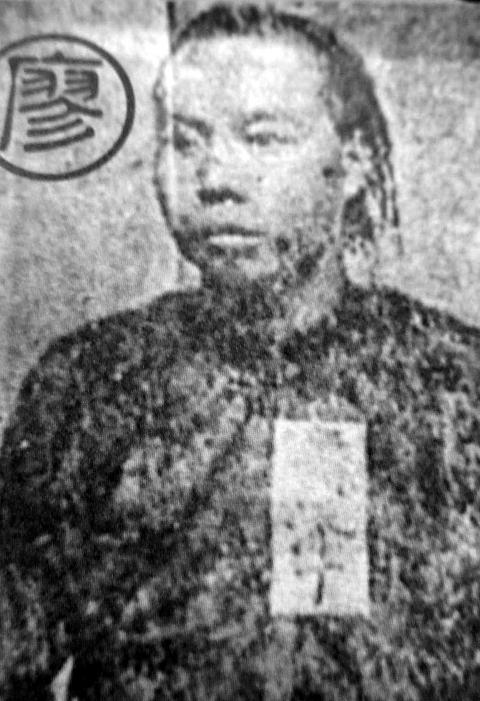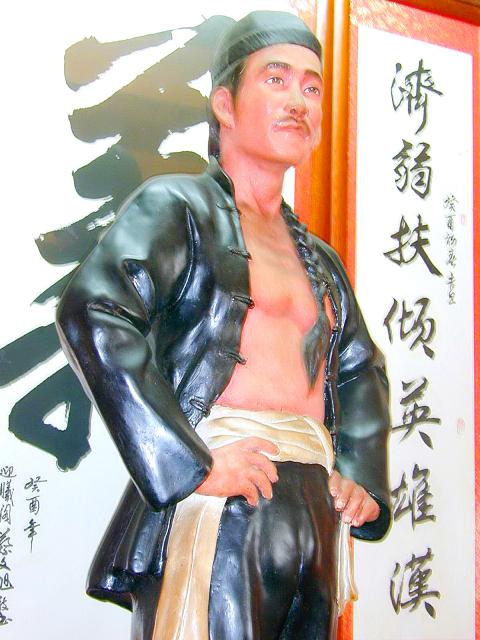Taiwan in Time: Nov. 16 to Nov. 22
Having already been sentenced to death in absentia and with the Japanese colonial police closing in, Liao Tien-ting (廖添丁) still met an unexpected end in a cave in what is today New Taipei City’s Bali District (八里). On the run after a three-month crime spree, the most common version of events is that Liao was betrayed by his friend Yang Lin (楊林), who informed the police about Liao’s whereabouts. Liao tried to shoot Yang upon realizing the truth, but the bullet got stuck. Yang picked up a nearby hoe and crushed Liao’s skull. It was 1909, and Liao was 26 years old.
There are probably as many versions of Liao’s death as there are of his life and legacy, and even the day of his death, Nov. 18, is disputed. After all, who knows what’s real or not about this anti-Japanese folk hero — often considered Taiwan’s Robin Hood — whose story has been adapted into countless children’s books, novels, television programs and even an orchestral suite and Cloud Gate Dance Theatre (雲門舞集) performance. He’s worshipped at the Liao Tien-ting Temple (廖添丁廟) in Bali — which also houses his grave — and in other places such as the Xia Hai City God Temple (霞海城隍廟) in Taipei.

Photo: Ou Su-mei, Taipei Times
Even the story about his gravestone is legendary. It’s said that shortly after Liao’s death, the wife of a Japanese officer who pursued Liao became ill. Desperate to seek a cure, the officer followed local advice to pray at Liao’s burial place and his wife recovered soon after. The officer then erected the gravestone and worshipped Liao as a foster son.
In July this year, the Taipei District Court displayed for the first time a verdict sentencing Liao to death for the killing of alleged police informant Chen Liang-chiu (陳良久), even though Liao died before he could be arrested. To the Japanese at that time, he was no more than a robber and murderer, but to Taiwanese it was a completely different matter.
According to the Taiwan Daily News (台灣日日新報), a newspaper published during the Japanese colonial era, people visited and prayed at Liao’s grave regularly, believing that as a ghost he could cure sickness and perform other miracles. A January 1910 article stated that there was no more space in front of the grave to place joss sticks. The Japanese banned the practice in March that year, but Liao’s legend simply kept growing as an yizei (義賊, righteous criminal) who fought against colonial injustice by robbing the rich and giving to the poor.

Photo: Chang Jui-chen, Taipei Times
His heroic deeds and extraordinary abilities are still celebrated today, as a children’s book published in 2008 depicts some of Liao’s most famous moments, including saving an old man from police brutality with the throw of a pebble, robbing a man who made his fortune by colluding with the Japanese, jumping out of windows, flying over roofs and disguising himself as an old lady while being pursued. Other books show Liao being involved in anti-Japanese organizations, one even stating that both his parents were killed in a Japanese invasion of their village.
Born in today’s Taichung in 1883, Liao was 12 years old when Taiwan became part of Japan. His household registry shows that he was sentenced in 1902 to 10 months and 15 days in prison for larceny, his third offense. Some say he was locked up between 1905 and 1909 for his fifth offense, and others say he continued committing minor robberies and thefts during that time.
Liao’s final spree began in July 1909, including an incident on Aug. 20 where he and several accomplices stole guns, ammunition and a sword from two police dormitories. He also killed Chen during this time, frequently making headlines as the man who just could not be caught. After committing his final string of robberies in early November, Liao fled to the cave where he ultimately met his end.
That’s all that is certain about Liao’s life; the rest probably grew out of embellishments by locals, who reconstructed Liao as a spiritual hero to ease their frustration against their colonial masters — after all, who doesn’t like stories where the oppressors are terrorized?
Historian Tsai Chin-tang (蔡錦堂) says that Liao’s legendary abilities are mostly likely rooted in newspaper reports detailing his elusiveness, including how he jumped out of a moving train, fell into a valley and survived.
After his death, Liao made headlines a few more times, including one about people claiming to have seen his ghost. His crime spree was also adapted by a Japanese playwright in 1911.
As to the story that he was Taiwan’s Robin Hood, there is no concrete evidence that Liao gave his loot to the poor. But as early as 1914, a Taiwanese opera script about Liao was published, already bearing the “righteous outlaw” moniker.
After the Chinese Nationalist Party (KMT) took over Taiwan, Liao’s image transformed once more — this time into an anti-Japanese hero. But things didn’t stop there, as he was well on the road to deification.
There had already been many supernatural tales about Liao, including the one with the Japanese officer and others about his spirit appearing here and there to administer justice. People at that time believed that if a vigorous person died, he would become a powerful ghost, and started praying at his grave for various reasons, including health and fortune. Another belief was that someone who died a violent or unnatural death would become a ligui (厲鬼, vengeful ghost) and must be pacified through worship.
Liao’s grave was rebuilt after the Japanese left and worshipping resumed. Interest in Liao grew after a feature film was made about his life in 1956, and a small shrine was built around his resting place in 1958.
Locals tried to expand the temple with Liao as the main deity in the 1970s, but the government rejected the proposal due to lack of historic evidence of his heroic deeds. The temple was still built, but with Guan Gong (關公), also a real-life hero-type, as the main deity and Liao as secondary. Nevertheless, most people refer to it as the Liao Tien-ting Temple, and with its completion in 1975, Liao had completed his journey from wanted criminal to a worshipped deity.
Taiwan in Time, a column about Taiwan’s history that is published every Sunday, spotlights important or interesting events around the nation that have anniversaries this week.

That US assistance was a model for Taiwan’s spectacular development success was early recognized by policymakers and analysts. In a report to the US Congress for the fiscal year 1962, former President John F. Kennedy noted Taiwan’s “rapid economic growth,” was “producing a substantial net gain in living.” Kennedy had a stake in Taiwan’s achievements and the US’ official development assistance (ODA) in general: In September 1961, his entreaty to make the 1960s a “decade of development,” and an accompanying proposal for dedicated legislation to this end, had been formalized by congressional passage of the Foreign Assistance Act. Two

Despite the intense sunshine, we were hardly breaking a sweat as we cruised along the flat, dedicated bike lane, well protected from the heat by a canopy of trees. The electric assist on the bikes likely made a difference, too. Far removed from the bustle and noise of the Taichung traffic, we admired the serene rural scenery, making our way over rivers, alongside rice paddies and through pear orchards. Our route for the day covered two bike paths that connect in Fengyuan District (豐原) and are best done together. The Hou-Feng Bike Path (后豐鐵馬道) runs southward from Houli District (后里) while the

On March 13 President William Lai (賴清德) gave a national security speech noting the 20th year since the passing of China’s Anti-Secession Law (反分裂國家法) in March 2005 that laid the legal groundwork for an invasion of Taiwan. That law, and other subsequent ones, are merely political theater created by the Chinese Communist Party (CCP) to have something to point to so they can claim “we have to do it, it is the law.” The president’s speech was somber and said: “By its actions, China already satisfies the definition of a ‘foreign hostile force’ as provided in the Anti-Infiltration Act, which unlike

Mirror mirror on the wall, what’s the fairest Disney live-action remake of them all? Wait, mirror. Hold on a second. Maybe choosing from the likes of Alice in Wonderland (2010), Mulan (2020) and The Lion King (2019) isn’t such a good idea. Mirror, on second thought, what’s on Netflix? Even the most devoted fans would have to acknowledge that these have not been the most illustrious illustrations of Disney magic. At their best (Pete’s Dragon? Cinderella?) they breathe life into old classics that could use a little updating. At their worst, well, blue Will Smith. Given the rapacious rate of remakes in modern